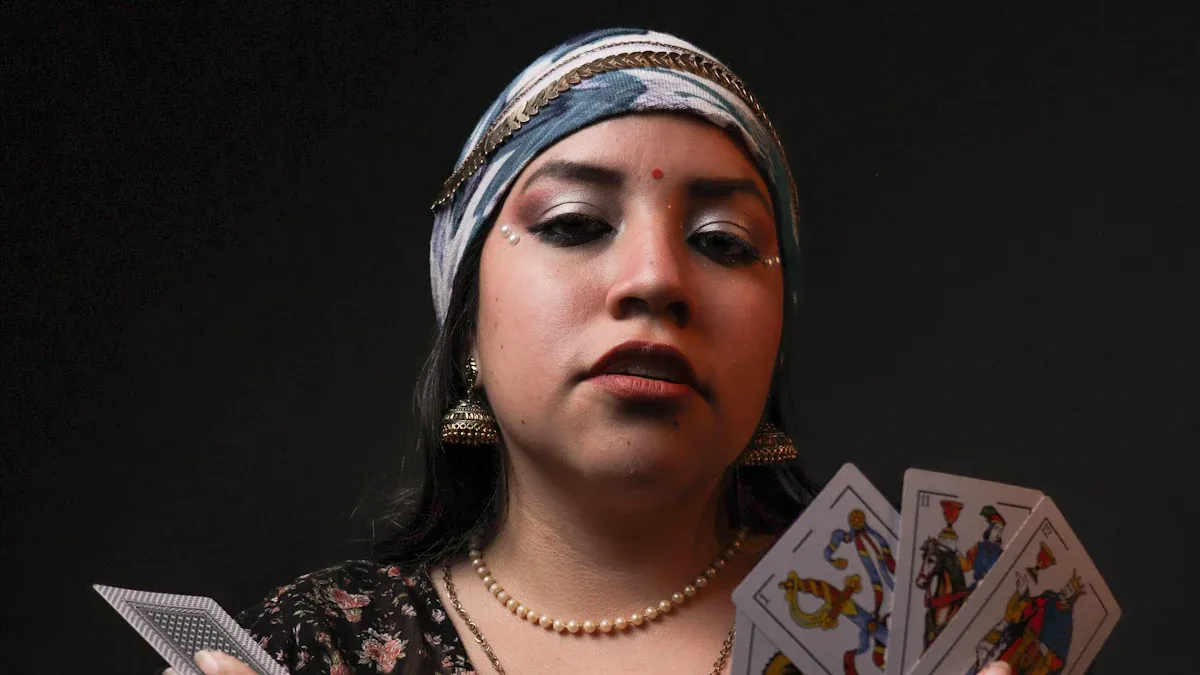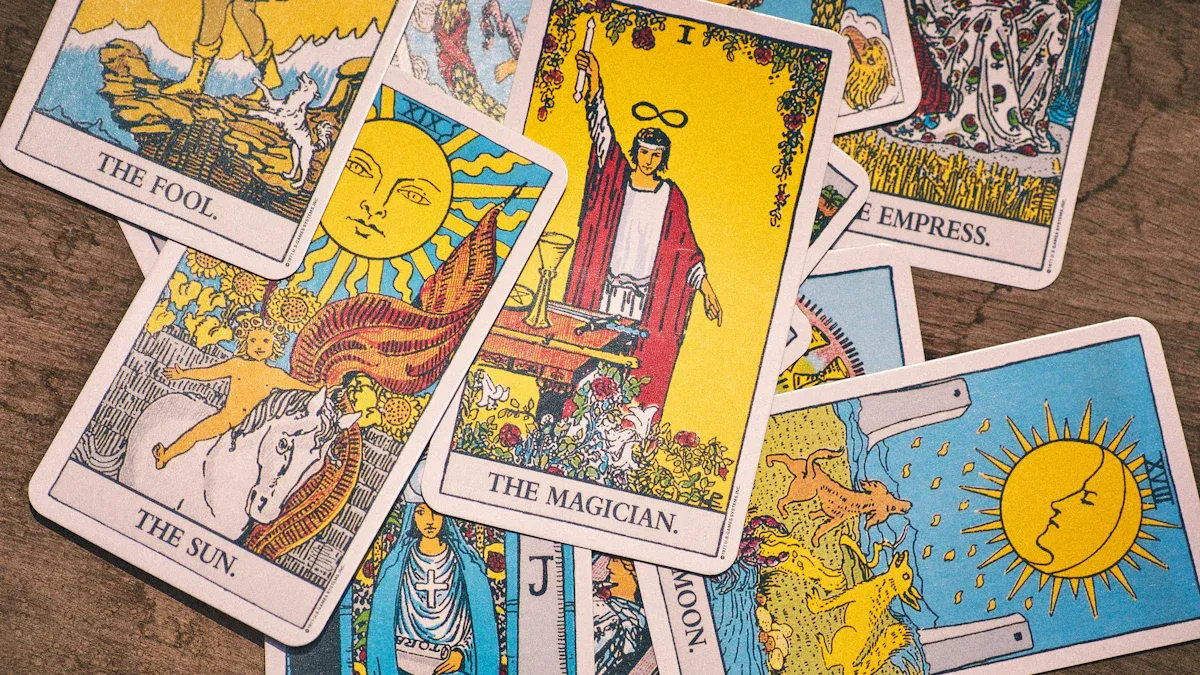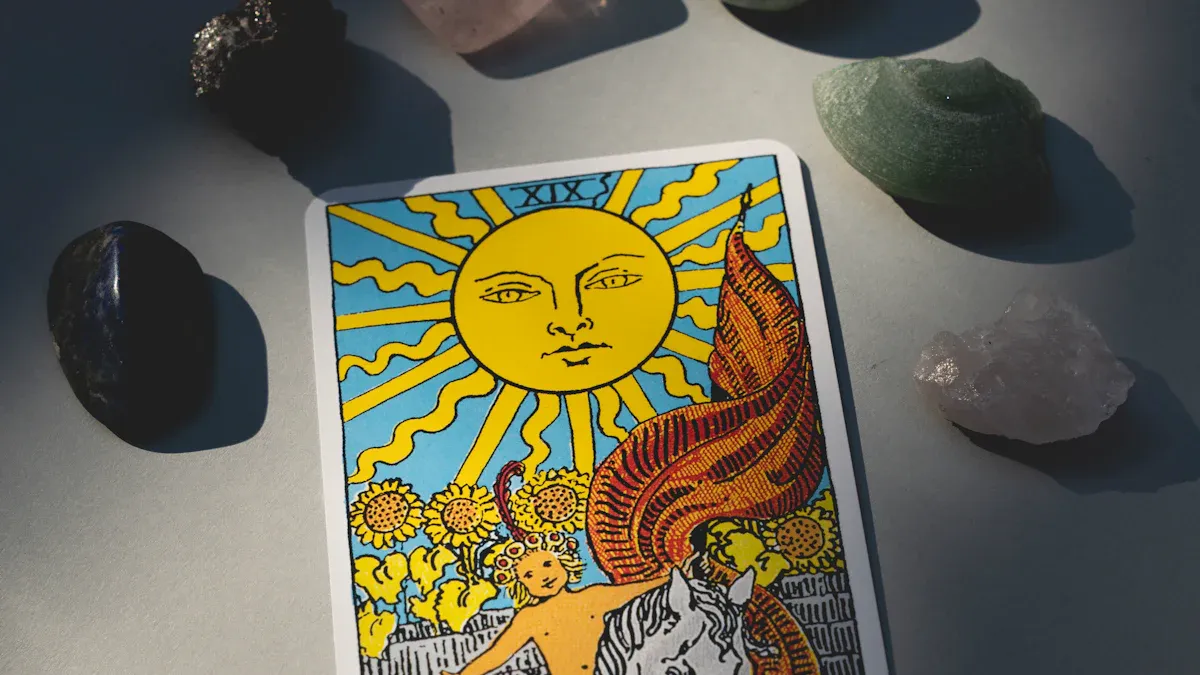
The Waite Rider deck is a unique and important creation in the world of tarot. Its history illustrates how it transformed old tarot traditions. The images on the cards, particularly in the Minor Arcana, convey stories. This evolution made the deck more accessible and user-friendly. Individuals from various cultures found it easier to connect with. Its symbols continue to assist people seeking guidance or inspiration today.
Key Takeaways
The Rider-Waite tarot deck changed tarot with its clear pictures and stories, making it easy for everyone to use.
Pamela Colman Smith’s artwork added feelings and meaning to the Minor Arcana, creating a new style for tarot cards.
The deck’s common symbols relate to human life, making it helpful for learning about yourself and thinking deeply.
The Rider-Waite deck was important in the 1970s New Age movement, making tarot popular for self-discovery.
Today, the Rider-Waite deck is still a main part of tarot reading, loved by both new and skilled users for its simple images.
The Historical Origins of the Rider-Waite Tarot Deck

The Collaboration Between Arthur Waite and Pamela Colman Smith
The Rider-Waite tarot deck was created by Arthur Waite and Pamela Colman Smith. Waite, born in 1857, was a British occultist who loved mystical ideas. He wanted to make a tarot deck that showed Western esoteric teachings. To do this, he asked Pamela Colman Smith, an artist born in 1878, to help. Smith was famous for her bold colors and detailed art.
In 1901, Smith joined the Hermetic Order of the Golden Dawn, a secret group studying magic and the occult. This group influenced her art style. By 1909, Waite hired her to design the deck. He let her use her creativity to show tarot themes. Smith added story-like pictures to the Minor Arcana, which was a new idea. This made the cards easier to understand. Experts like Mary Greer have praised Smith’s work, saying it helped make the deck so popular.
Waite and Smith’s teamwork was more than just work. It was a mix of deep knowledge and creative art. Together, they made a deck that still inspires people today.
The Role of the Golden Dawn in Shaping the Deck
The Golden Dawn had a big impact on the Rider-Waite tarot deck. This secret group, started in the late 1800s, studied magic, astrology, and alchemy. Both Waite and Smith were members, and the group’s ideas shaped the deck’s symbols.
Samuel Liddell MacGregor Mathers, the Golden Dawn’s founder, added many symbols to the deck. For example, the Strength and Justice cards were switched to match astrology lessons from the group. The deck also borrowed ideas from older works, like Eliphas Levi’s symbols and the Sola Busca tarot from the 1400s. These influences made the deck rich with meaning and connected to Western spiritual traditions.
Influence | Description |
|---|---|
Eliphas Levi | His symbols inspired parts of the deck’s design. |
Golden Dawn | Astrology and symbols from the group were included. |
Sola Busca | Some Minor Arcana images were based on this old deck. |
Paul Christian | Major Arcana ideas came from his Egyptian-style descriptions. |
Etteilla | Card meanings were influenced by his interpretations. |
The Golden Dawn’s teachings made the Rider-Waite deck more than just a fortune-telling tool. It became a symbol of deep spiritual ideas. Waite and Smith used these ideas to create a deck that spoke to both spiritual seekers and everyday people.
The First Publication of the Waite Rider Deck in 1909
The Rider-Waite tarot deck was first printed in 1909 by Rider & Co., a London publisher. This was a big moment for tarot history. For the first time, all 78 cards, including the Minor Arcana, had detailed pictures. These pictures told stories, making the deck easier to use.
The first version, called the “Roses & Lilies” edition, came with Waite’s book, The Pictorial Key to the Tarot. This book explained how to read the cards, making them even simpler to understand. The deck was shown to the public on December 10, 1909, at an arts and crafts fair. People could also pre-order it through Rider & Co.’s October catalog.
Detail | Description |
|---|---|
Designer | Arthur Edward Waite |
Illustrator | Pamela Colman Smith |
First Published | 1909 |
Publisher | Rider & Co., London |
Accompanying Book | The Pictorial Key to the Tarot |
Editions | First edition called “Roses & Lilies”; four more editions until 1940. |
The release of the Rider-Waite tarot deck changed tarot forever. Its creative design and universal symbols made it a key part of tarot history. Even today, it is one of the most loved and widely used tarot decks in the world.
The Artistic and Symbolic Legacy of the Rider-Waite Tarot

Pamela Colman Smith’s Artistic Contributions
Pamela Colman Smith helped create the Rider-Waite tarot deck. Her art made the cards interesting and easy to use. She was inspired by the Golden Dawn, a group studying magic. This influence mixed with her bold colors and detailed designs. Her work appealed to both new and experienced tarot readers.
People admire her creativity and artistic talent. Even so, Smith faced challenges like little recognition and money problems. She worked on many art projects, but her tarot illustrations are her most famous. Today, her work inspires artists and tarot fans all over the world.
The Revolutionary Depiction of Minor Arcana in Tarot Cards
The Rider-Waite tarot deck changed how tarot cards looked. Before this deck, only the Major Arcana had detailed pictures. The Minor Arcana had simple designs, which were harder to understand. Arthur Waite wanted to fix this. He worked with Pamela Colman Smith to make a new kind of deck.
Smith added story-like pictures to the Minor Arcana. These scenes made the cards easier to read and more emotional. For example, the Ten of Swords shows a person under a dark sky. This image represents endings and fresh starts. Her work set a new standard for future tarot decks.
Universal Archetypes and Symbolism in the Rider-Waite Tarot
The Rider-Waite tarot deck is special because of its symbols. Each card shows ideas that everyone can relate to, like love or change. For example, the Chariot card stands for strength and overcoming challenges.
Experts study the deck using art history and psychology. They compare its symbols to older tarot decks, showing its deep roots. This mix of ideas makes the deck a timeless tool for learning about yourself and growing spiritually.
Aspect | Description |
|---|---|
Focus | Understanding symbols and meanings in the Rider-Waite deck |
Methodology | Combines Art History and Jungian psychology |
Relation | Links to older tarot decks and their designs |
The Rider-Waite tarot deck connects with people from all backgrounds. Its symbols and stories continue to inspire and guide many today.
The Cultural Impact of the Rider-Waite Tarot Deck
The Deck’s Role in the 1970s New Age Movement
The 1970s was a big time for the Rider-Waite tarot deck. During this period, the New Age movement grew popular. People started exploring spiritual practices like tarot. The Rider-Waite deck, reprinted in 1970 by U.S. Games Systems, became very important. Its constant availability since then shows its lasting value.
The New Age movement encouraged using tools like tarot for self-growth. The Rider-Waite deck, with its clear pictures and universal symbols, became a favorite. Authors like Eden Gray wrote books about tarot in the 1960s. Her work made the deck more popular. By 1969, her books inspired many to try tarot readings. This linked the deck to New Age ideas.
The Rider-Waite deck also influenced other tarot designs. For example, David Palladini’s Aquarian Tarot, inspired by it, became popular too. This shows how its style shaped new decks. By the 1980s, tarot had become a big industry. The Rider-Waite deck stayed at the center of it. Its role in the New Age movement made it a key tool for spiritual exploration.
How the Rider Waite Tarot Shaped Modern Spirituality
The Rider Waite tarot deck has changed modern spirituality in big ways. Arthur Waite and Pamela Colman Smith made it more than a fortune-telling tool. They added deep symbols and themes that connect to human experiences. This makes the deck helpful for personal growth and reflection.
The deck’s pictures help people use their intuition. Older decks needed you to memorize hard symbols. But the Rider Waite deck tells stories on each card. For example, the Fool card shows a traveler near a cliff. It represents new beginnings and taking chances. This makes the deck easy for anyone to use.
Social media has made the deck even more popular. On TikTok, over 13 million posts use #tarot. Many young people share their tarot experiences online. A 2021 survey found that 51% of U.S. teens and young adults have used tarot cards. This shows how the Rider Waite deck stays important in today’s world.
The Deck’s Global Popularity and Accessibility
The Rider Waite tarot deck is famous worldwide because it’s easy to use. It was the first deck to sell widely and set a standard for tarot. Its detailed Minor Arcana cards help people rely on pictures instead of memorizing symbols. This simple approach keeps it popular.
During the pandemic, more people turned to tarot for comfort. Sales of the Rider Waite deck went up a lot, according to U.S. Games Systems. Experts predict the global tarot market will grow 3% yearly from 2023 to 2029. This shows how the deck remains important in a growing industry.
The Rider Waite deck also inspires new tarot creations. Many modern oracle decks borrow its structure and symbols. This proves its lasting influence on tarot history. Its creators mixed mystical knowledge with creative art. This made the deck a timeless tool for spiritual practices and divination.
The Rider-Waite Tarot’s Influence on Modern Tarot Practices
The Deck’s Legacy in Contemporary Tarot Decks
The Rider-Waite tarot deck changed how tarot cards are designed. Pamela Colman Smith’s artwork set a new standard for tarot decks. Before this, many decks used simple symbols that were hard to understand. The Rider-Waite deck added detailed pictures and universal themes. These changes made the cards easier for people to read.
Today, many new tarot decks are inspired by the Rider-Waite deck. Modern decks often keep its structure but add diverse and inclusive images. These updates reflect the changing needs of tarot readers. This shows how the Rider-Waite deck stays important as a tool for spiritual growth.
Pamela Colman Smith and Arthur Waite showed how art can change tarot meanings. Their work made the deck useful for both beginners and experts. This lasting impact keeps the Rider-Waite deck central to tarot practices today.
The Rider-Waite Tarot in Popular Culture and Media
The Rider-Waite tarot deck is famous in movies, TV, and books. Its pictures often represent mystery or spiritual ideas. For example, movies like The Craft and Practical Magic use tarot cards to tell stories and develop characters.
Social media has made the deck even more popular. On TikTok and Instagram, people share readings using the Rider-Waite deck. These posts help younger audiences learn about tarot. The deck’s role in pop culture shows how it connects old traditions with modern life.
The deck also inspires artists and writers to explore tarot meanings. This mix of art and spirituality shows why the Rider-Waite deck is timeless. It continues to shape how people use and understand tarot today.
Why the Deck Remains a Cornerstone of Tarot Reading Today
The Rider-Waite tarot deck is still important because it’s clear and flexible. Its detailed pictures make reading tarot cards simpler. You can focus on your feelings instead of memorizing symbols. Each card tells a story, helping you understand its meaning.
The deck changed tarot in America after it was introduced in 1971. It became one of the first decks widely sold in the U.S., replacing older styles like the Marseilles deck. Even with new designs, the Rider-Waite deck’s main ideas stay the same. This keeps it useful for exploring life’s challenges and experiences.
The deck’s ability to adapt also makes it popular. Whether you’re new to tarot or experienced, its universal themes and clear images make it easy to use. As tarot grows worldwide, the Rider-Waite deck remains a key part of tarot history and modern spirituality.
The Rider-Waite tarot deck shows how art and symbols last. Its creative design and universal ideas make it special. It’s more than just cards; it shapes modern spirituality. People still use it for guidance and inspiration today.
Tip: If you’re new or skilled at tarot, the Rider-Waite deck helps you explore life’s questions. Its lasting popularity makes it a key part of tarot worldwide.
This deck’s rise from small beginnings to fame shows its cultural and spiritual importance.
FAQ
What makes the Rider-Waite tarot deck unique?
The Rider-Waite deck is special because of its detailed pictures. These images, especially in the Minor Arcana, tell stories. They make the cards easier to understand and use. Its symbols connect with people everywhere. This makes it a timeless tool for self-discovery and spiritual growth.
Can beginners use the Rider-Waite tarot deck?
Yes! The deck’s clear pictures and storytelling style are great for beginners. You don’t need to learn hard symbols. Instead, the images help guide your thoughts and feelings. It’s a perfect choice for anyone new to tarot.
Why is Pamela Colman Smith important to the deck?
Pamela Colman Smith drew the Rider-Waite deck. Her bright colors and detailed art changed tarot forever. She added scenes to the Minor Arcana, making the cards easier to use. Her work still inspires artists and tarot fans around the world.
How has the Rider-Waite deck influenced modern tarot?
The Rider-Waite deck changed how modern tarot decks are made. Many new decks copy its design and symbols. Its storytelling style and universal themes shaped how people read and create tarot cards today.
Is the Rider-Waite deck still relevant today?
Yes! The Rider-Waite deck is still one of the most loved tarot decks. Its clear pictures and timeless symbols make it easy to use. Whether you’re new or experienced, this deck offers guidance and inspiration.
Tip: If you’re starting out, the Rider-Waite deck is a great choice for learning tarot.


